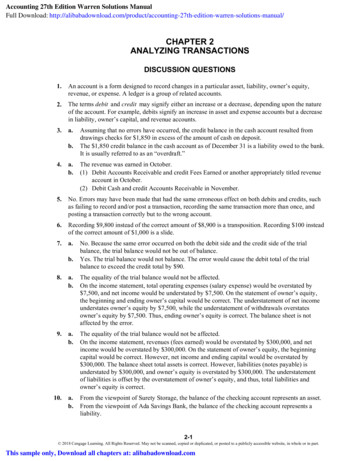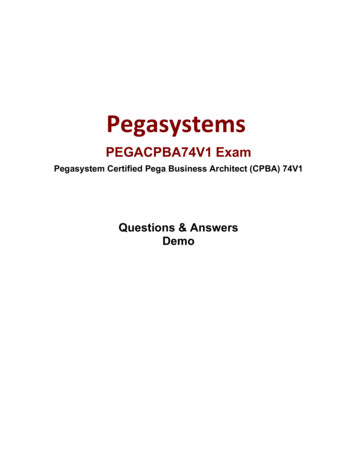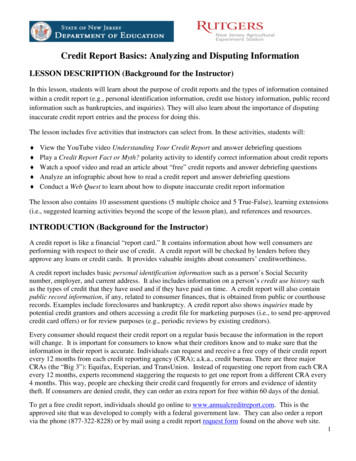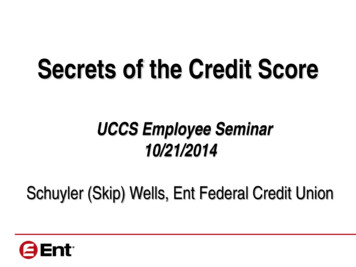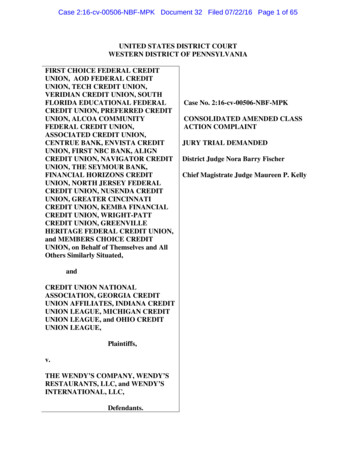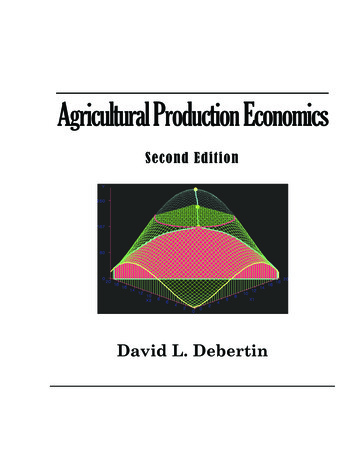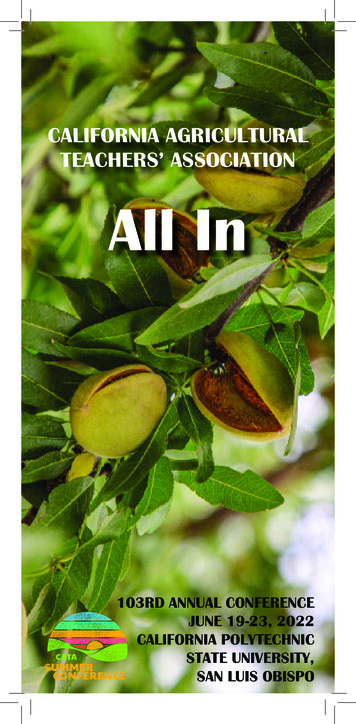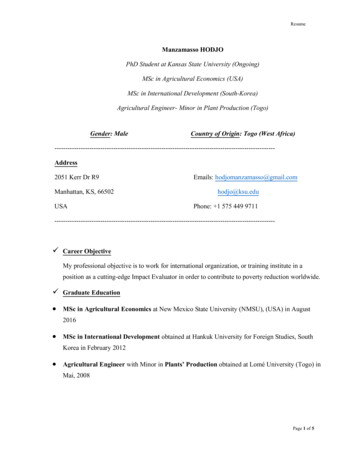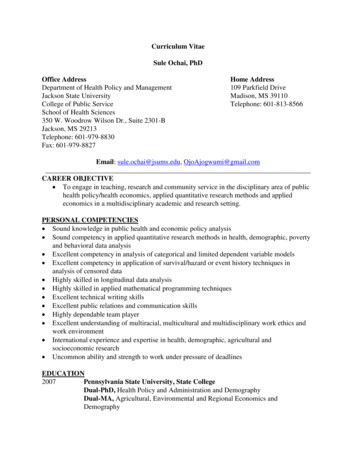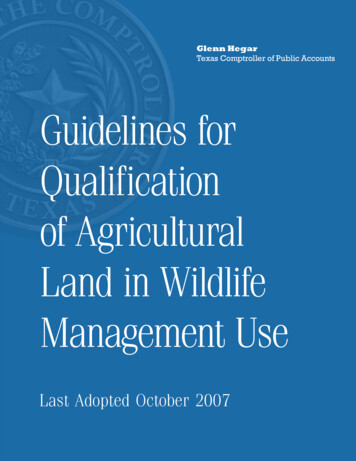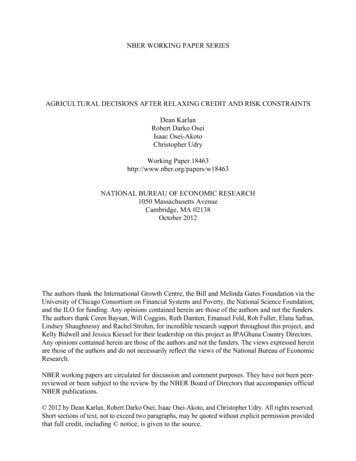
Transcription
NBER WORKING PAPER SERIESAGRICULTURAL DECISIONS AFTER RELAXING CREDIT AND RISK CONSTRAINTSDean KarlanRobert Darko OseiIsaac Osei-AkotoChristopher UdryWorking Paper 18463http://www.nber.org/papers/w18463NATIONAL BUREAU OF ECONOMIC RESEARCH1050 Massachusetts AvenueCambridge, MA 02138October 2012The authors thank the International Growth Centre, the Bill and Melinda Gates Foundation via theUniversity of Chicago Consortium on Financial Systems and Poverty, the National Science Foundation,and the ILO for funding. Any opinions contained herein are those of the authors and not the funders.The authors thank Ceren Baysan, Will Coggins, Ruth Damten, Emanuel Feld, Rob Fuller, Elana Safran,Lindsey Shaughnessy and Rachel Strohm, for incredible research support throughout this project, andKelly Bidwell and Jessica Kiessel for their leadership on this project as IPAGhana Country Directors.Any opinions contained herein are those of the authors and not the funders. The views expressed hereinare those of the authors and do not necessarily reflect the views of the National Bureau of EconomicResearch.NBER working papers are circulated for discussion and comment purposes. They have not been peerreviewed or been subject to the review by the NBER Board of Directors that accompanies officialNBER publications. 2012 by Dean Karlan, Robert Darko Osei, Isaac Osei-Akoto, and Christopher Udry. All rights reserved.Short sections of text, not to exceed two paragraphs, may be quoted without explicit permission providedthat full credit, including notice, is given to the source.
Agricultural Decisions after Relaxing Credit and Risk ConstraintsDean Karlan, Robert Darko Osei, Isaac Osei-Akoto, and Christopher UdryNBER Working Paper No. 18463October 2012, Revised July 2013JEL No. C93,D24,D92,G22,O12,O13,O16,Q12,Q14ABSTRACTThe investment decisions of smallscale farmers in developing countries are conditioned by their financialenvironment. Binding credit market constraints and incomplete insurance can reduce investment inactivities with high expected profits. We conducted several experiments in northern Ghana in whichfarmers were randomly assigned to receive cash grants, grants of or opportunities to purchase rainfallindex insurance, or a combination of the two. Demand for index insurance is strong, and insuranceleads to significantly larger agricultural investment and riskier production choices in agriculture. Thebinding constraint to farmer investment is uninsured risk: when provided with insurance against theprimary catastrophic risk they face, farmers are able to find resources to increase expenditure on theirfarms. Demand for insurance in subsequent years is strongly increasing with farmer's own receiptof insurance payouts, with the receipt of payouts by others in the farmer’s social network, as well aswith recent poor rain in their village. Both investment patterns and the demand for index insuranceare consistent with the presence of important basis risk associated with the index insurance, with imperfecttrust that promised payouts will be delivered, as well as with overweighting recent events.Dean KarlanDepartment of EconomicsYale UniversityP.O. Box 208269New Haven, CT 06520-8629and NBERdean.karlan@yale.eduRobert Darko OseiISSERrdosei@isser.edu.ghIsaac Osei-AkotoISSERioseiak@ug.edu.ghChristopher UdryEconomic Growth CenterYale UniversityBox 208269New Haven, CT 06520and NBERudry@yale.edu
1. IntroductionIncomplete markets shape the investments of firms. In the rural areas of developing countries, financialmarket imperfections are pervasive, and there are broad regions in which almost every householdmanages farmland, effectively a firm. In these contexts, households facing constrained access to creditor insurance may choose to invest less, or differently, on their farms than they would under perfectmarkets. Agricultural policy, particularly in Africa, focuses on increasing investment levels by farmers.Policies have commonly focused on reducing risk or increasing access to capital, with implicitassumptions of market failures in one or more such domains.Before this study began, we asked smallholder farmers in northern Ghana about their farming practicesin a series of qualitative focus groups. Discussions were guided toward identifying constraints to furtherinvestment. Farmers most often cited lack of capital as the reason they had not intensified farminvestment—but also farmers understood the risk of unpredictable rainfall, and claimed to reduce theirfarm investment because of it. Thus, we seek to test the importance of capital constraints and uninsuredrisk, separately and together, as financial market imperfections hindering optimal investment bysmallholder farmers. We do this with a multi‐year, multi‐arm randomized trial with cash grants, rainfallinsurance grants and rainfall insurance sales in northern Ghana.The welfare gains from improving financial markets could be large, for three reasons. First, if either riskor limited access to credit is discouraging investment, the marginal return on investments may be high.Existing evidence from fertilizer in northern Ghana suggests that these returns are indeed high.1 Yet themedian farmer in northern Ghana uses no chemical inputs.2 Second, agriculture in northern Ghana isalmost exclusively rain‐fed. Thus weather risk is significant and index insurance on rainfall has promise.Third, we have strong evidence in the region that rainfall shocks translate directly to consumptionfluctuations (Kazianga and Udry 2006). Thus mitigating the risks from rainfall should lead to not justhigher yields but also smoother consumption.To understand how capital and risk interact, and under what circumstances underinvestment occurs, weexperimentally manipulate the financial environment in which farmers in northern Ghana makeinvestment decisions. We do so by providing farmers with cash grants, grants or access to purchaserainfall index insurance or both. Using rainfall index insurance rather than crop insurance eliminates1Experiments on farmers’ plots across 12 districts of northern Ghana in 2010 with inorganic fertilizer in northernGhana showed for an additional expenditure of 60 per acre (inclusive of the additional cost of labor), fertilizer usegenerates 215 of additional output per acre (Fosu and Dittoh 2011).2This fact is derived from the control group of farmers in the first year of our survey, described in section 3 below.2
moral hazard and adverse selection because payouts depend only on observable rainfall realizations.This is beneficial for theoretical and research reasons, in that it allows us to isolate the impact of risk oninvestment decisions, and is relevant for policy reasons, given the historical challenges of crop insurance(Hazell, Pomareda, and Valdés 1986) and recent policy attention to index insurance.The experiments are motivated by a simple model which starts with perfect capital and perfectinsurance markets, and then shuts down each. Farm investment is lower than in the fully efficientallocation if either market is missing (and land markets are also shut down, given the restrictions of theland tenure system in northern Ghana (Yaro and Abraham 2009)). If credit constraints are binding, thenprovision of cash grants increases investment, but the provision of grants of insurance reducesinvestment. In contrast, when insurance markets are incomplete, provision of cash grants has a minimalimpact on investment, but investment responds positively to the receipt of an insurance grant.To test these predictions, we turn to a three‐year multi‐arm randomized trial.3 In year one, weconducted a 2x2 experiment: maize farmers received (a) a cash grant of 85 per acre or no cash grant(average grant of 420 per farmer), and (b) a rainfall insurance grant with an actuarially fair value of 47per acre or no rainfall insurance grant. In year two, we conducted another cash grant experiment, butonly offered rainfall insurance for sale at randomly‐varied prices ranging from one eighth of actuariallyfair to market price (i.e., actuarially far plus a market premium to cover servicing costs) rather thangiving some out for free as in year one. In year three, we did not conduct another cash grantexperiment, but the insurance pricing experiment continued.Four elements distinguish our data and experiments: (1) the cash grant experiment to measure theeffect of capital constraints on investment and agricultural income (most of the existing complementaryresearch is on the insurance component), (2) the provision of free insurance, in order to observeinvestment effects on a full population rather than just those willing to buy (Cole et al (2011) is a notablecomplementary study), who provide grants of free insurance to farmers in India), (3) the multi‐yearsetup, and (4) a demand curve from barely positive prices (1/8 of actuarially fair) all the way toapproximate market prices (i.e., actuarially fair plus a 50% premium to cover servicing costs). In theDiscussion section of this paper we relate our results to the complementary literature on risk and capitalcapitals for agriculture.3Conducted as a “natural field experiment” in the sense that all grants and insurance were offered through anNGO, and although after the first year individuals obviously knew that researchers were conducting surveys, thegrants and insurance were presented as those of an NGO, not researchers.3
We find strong responses of agricultural investment to the rainfall insurance grant, but relatively smalleffects of the cash grants. We consider both of these results striking. Our main result is that uninsuredrisk is a binding constraint on farmer investment: when provided with insurance against the primarycatastrophic risk they face, farmers are able to find resources to increase expenditure on their farms.This result is important in two dimensions: first, it demonstrates the direct importance of risk inhindering investment; second, the fact that farmers came up with cash to increase investment merely asa consequence of getting rainfall insurance shows that liquidity constraints are not as binding astypically thought.4 Thus, the strongest evidence on capital constraints comes not from the capital granttreatment estimate, but rather from the insurance‐only results compared to control. Furthermore, aswe will discuss later, the treatments are not directly comparable, as one needs assumptions of perfectmarkets in order to compare the intensity of the two, and obviously a key lesson from this and similarresearch is that there are not perfect capital and insurance markets in this type of setting. This secondfact, combined with the lack of a large response to cash grants, suggests that agricultural credit marketpolicy alone will not suffice to generate higher farm investment. This is an important result, given thelarge emphasis throughout the world in agricultural credit policy.We also show that there is sufficient demand to support a market, and will discuss in more length in theDiscussion section the ensuing policy and market issues in Ghana. Here, we find that at the actuariallyfair price, 40 to 50 percent of farmers demand index insurance, and they purchase coverage for morethan 60 percent of their cultivated acreage. Patterns of insurance demand are consistent with farmersbeing conscious of the important degree of basis risk associated with the index insurance product. But,there are important frictions, such as trust and recency bias (i.e., overweighting of recent events), in theinsurance market. Farmers do not seem to have complete trust that payouts will be made when rainfalltrigger events occur, so the demand for index insurance is quite sensitive to the experience of thefarmer and others in his social network with the insurance product. Demand increases after either thefarmer or others in his network receive an insurance payout, and demand is lower if a farmer waspreviously insured and the rainfall was good, so no payout was made. The irony is unfortunate:insurance offers its largest benefit for low‐probability high‐loss events, yet rare payouts harm demand.This could easily lead to insurance market failures if not addressed in the design of policies. We discussthis in section 7.4This does not mean that there are never liquidity constraints, since individuals could still be constrained partiallyon the farm, or in other domains of their life. These farmers are very poor, and the prospect of potentially bindingliquidity constraints in the future strengthens the responsiveness of investment to insurance, as discussed inSection 2.4
In the next section, we provide a simple model of investment in a set of different financialenvironments. Section 3 describes the empirical setting, the experimental interventions, and the datacollection process. Section 4 provides the key results on the effects of cash and insurance grants on farminvestment. Given these results, section 5 provides a model of the demand for insurance andagricultural investment when farmers do not face binding credit constraints. Section 6 provides resultson the demand for index insurance, characterizes patterns of investment given the availability of indexinsurance at randomized prices, and explores the effects of social interactions on insurance demand.Section 7 discusses the implications of our results in the context of the academic literature and policyissues, and Section 8 concludes.2. Investment and the Financial EnvironmentIn an environment with well‐functioning markets, including markets for insurance and capital, thestandard neoclassical separation between production and consumption holds and farmers’ input choiceson a particular plot are independent of their wealth and their preferences. Investment in inputsmaximize the present discounted value of the (state‐contingent) profits generated by thoseinvestments. Where insurance markets are imperfect or absent, or credit constraints bind, separation nolonger holds, and the randomized provision of capital grants or insurance that pays off in certain statesmay influence farmers’ investment choices. The purpose of this section is to provide a simple model thatpermits us to use the investment response to capital grants and/or the provision of insurance to drawconclusions about the financial environment that farmers face.A minimal model sufficient for this purpose includes 2 periods, production, risk, and the appropriate0financial markets. Preferences over consumption in the first period ( c ) and in the various states of thesecond period (cs ) , with probability of state s equal to s and a discount factor b , are1(1)u(c 0 ) b åps u(cs1 ).s SWe start with an environment with a perfect credit market and complete informal risk‐pooling. Thehousehold (with exogenous cash on hand Y) has access to a market on which it can buy (or sell) a riskfree asset (a) which earns (or pays) interest R ( 1 , to simplify notation later). The household is also amember of an informal risk sharing group which permits the efficient ex‐post pooling of all risk. This5
informal risk sharing operates such that every household consumes the expected value of its secondperiod consumption in any realized second period state.The farmer has a concave production technology that provides second period output equal to f s ( x ) instate s after a vector of inputs x are committed in the first period. To simplify some of the notationwhich follows, we let S {L , H } with f L ( x ) f H ( x ). We also assume that there are two types ofinputs, x r and x r such that the marginal product of a ‘risky’ input ( xr ) is lower in state L than in H,while the converse is true of the ‘safe’ input x r . To simplify and sharpen the contrast between riskyand safe investments, we make the extreme assumptions that the marginal return on x r is zero in thelow state ( L ) and similarly for x r in the high state ( H ) , but this is not essential for any of our results.Our empirical focus will largely be on the risky inputs, which comprise the inputs into farm production innorthern Ghana. These include field preparation, fertilizer and pesticide use, weeding and cultivationactivities, all of which have a higher return when growing conditions like rainfall are good.5 This ofcourse need not be the case for all agricultural investments in all parts of the world: irrigation would bethe archetypical investment with a higher payoff in state L than in H, but there is no irrigation in oursample.In anticipation of our two‐pronged intervention, let k denote a cash grant provided to the farmer in thefirst period, and k s denote a state‐contingent payout promised if s occurs in the second period. k and k scorrespond to our experimental interventions providing grants of, respectively, capital and rainfall indexinsurance. We are not concerned here with changes in the price of inputs, so we choose units so thatthe price of each input is 1. Thus the household maximizes (1) subject toc 0 Y - x r - x r - a k(2)cL1 cH1 c 1 x ³ 0.å ps ( fs (x) Ra ks )s ÎSWe have assumed that the risk pooling group is sufficiently diverse that there is no aggregate risk.6 Thisextreme assumption serves to focus on the implications of binding credit constraints in the absence ofany risk‐based motivation for moving resources across periods. The household chooses a such that5The assumption that these inputs have a lower return in the low state corresponds to farmer accounts of theirpractices in northern Ghana, and there is agronomic support as well. See Amujoyegbe et al. (2007).6Thus all the rainfall risk is fully pooled: if a farmer realizes poor rainfall he receives a transfer from the pool equalto H ( f H ( x ) k H ) L ( f L ( x ) k L ) f L ( x ) k L . If the same farmer realizes good rainfall, he makes a6
u '( c 0 ) R u '( c1 ) u '( c1 )(3)and farm investment satisfies(4) R L f L ( x) f ( x) f ( x) f ( x) f ( x) f ( x) H H H H H H L L; R L L; xr xr xr x r x r x rfor the inputs x r and x r (we assume the Inada conditions on f H ( x ) and f L ( x ) so that the non‐negativity constraint on x never binds).With complete credit markets and full risk‐pooling, farm investment is independent of resources (Y) andpreferences: investment is fully determined by equation (4) which depends only on R, the probabilitiesof rainfall outcomes and the physical characteristics of the production function. Neither a capital grantnor an insurance policy has any influence on farm investment:dxr dxr dx r dx r 0.dk dks dkdks(5)We now introduce, in turn, capital constraints and incomplete insurance markets.2.1 Capital ConstraintsSuppose that borrowing is not possible: add the constraint a 0 to the constraint set. We will considersituations in which this constraint binds. Informal consumption pooling remains complete, so everyhousehold consumes the expected value of its consumption in any state. With a 0 binding the firstorder conditions become(6)u (c 0 ) u (c1 )andtransfer to the pool equal to f H ( x ) k H H ( f H ( x ) kH ) L ( f L ( x ) k L ) . Thisis of course anidealized representation of risk pooling, but it corresponds to one particular Pareto efficient allocation of risk, andis akin to the moral economy described by Scott (1976).7
(7)u (c 0 ) bu (c1)pH¶fH (x )¶f (x ) bu (c1)pL L .¶xr¶x rThe implicit function theorem immediately implies(8)dx r dx rdx dx 0 r , r .,dk dkdkL dkLThe capital grant reduces the shadow price of the binding borrowing constraint, raising the relativevalue of consumption in the future and therefore inducing higher investment in x (i.e., both x r and x r ).In contrast, the promise of future resources, even in the bad state L, increases that shadow price andlowers the relative value of consumption in the future. Hence investment in any input in x falls withpromised contingent payments.2.2 Imperfect Insurance1In the extreme, there is no informal risk pooling, so cs fs (x ) Ra ks . The household chooses x rsuch that(9)é p u (c1 )ù¶f (x )L;R êê L 1 úú H1¶x rêë pH u (cH )úûchooses x r so that(10)é p u (c1 )ù¶f (x )Hê; 1 úú LRê H1¶x rëê pL u (cL )ûúand chooses a such that(11)u '(c0 ) Lu '(c1L ) H u '(c1H ).First, note that when insurance is absent and f H ( x ) f L ( x ) , then8
H(12) f H ( x ) f ( x ). R L L xr x rRelative to (4) with complete markets, there is overinvestment in the safe input and underinvestment inthe risky input.***Let {a , xr , x r } solve (9), (10) and (11) when k 0. If u(.) is CARA then investment in either the risky inputx r or the safe input x r is invariant with respect to the capital grant k, but the amount invested in therisk‐free asset (a) increases with the capital grant k, i.e., a *k a * . {a , xr , x r } is optimal when k 0*k**becausecH1 - cL1 fH (x*) - kLand thus the ratios of marginal utilities in (9) and (10) are unaffected by k. In contrast, increases inpromised payouts in the bad state reduce (increase) the LHS of (9) (the LHS of (10)). Therefore, withCARA preferences, the absence of informal insurance implies that 0 CARA preferences 0 dx rdx r . Conversely, withdkdkLdx rdxdxdx r . The extreme conclusion that r r 0 relies on thedkdkLdkdk*k*k*kCARA assumption. For the more reasonable case of decreasing absolute risk aversion, {a , x r , xr }with xr xr and x r xr solves (9)‐(12) for k 0 because the absolute degree of risk aversion falls*k**k1*1as cL increases (and cL increases with a*k ). Thus, with imperfect insurance and decreasing absoluterisk aversion we have(13)dxr dxrdx dx 0 r , r .,dk dkLdk dkLDifferent mechanisms underlie the positive responses of risky investment in agriculture in response tothe cash grant and the grant of index insurance. The cash grant increases cash on hand, saving in thesafe asset and thus consumption in either state of the second period. With decreasing absolute riskaversion, this implies more investment in the risky input. Index insurance directly increases consumptionin the low state of period 2, which implies greater investment in the risky input and less investment inthe safe input.9
2.3 Capital Constraints and Imperfect InsuranceWith a 0 binding, the marginal utility of consumption in period 0 remains strictly greater than theexpected marginal utility in period 1 and the analogue to (7) remain first order conditions for x. Sincea 0, c 0 Y x r xr k and cs f s ( x ) k s the implicit function theorem implies1(14)dxr dx rdx dx 0 r , r,dk dkdks dksfor the inputs x r and x r .The model is stark in its simplicity. We have distinguished sharply between the risky and safe inputs x rand x r , and between these inputs and the safe asset a. In fact, farmers have access to a portfolio ofinput and investment choices with an array of varying payoffs in a vast set of possible states of theworld. In rainfed northern Ghana, almost all agricultural activities require investment in inputs whichhave a higher return in good rainfall conditions than they do in years of drought or flood and correspondto a greater or lesser degree to type x r . Households may in addition have access to some limitedactivities (discussed below) that provide relatively good returns in poor years, corresponding to x r .The restriction of the model to two periods sharpens the contrast between the implications of bindingcapital constraints and those of imperfect insurance. With an extended time horizon, a farmer with noaccess to insurance markets can use his access to credit markets to smooth transitory rainfall shocks. Ifin addition the farmer faces an exogenous limit on his or her access to credit, he may accumulate bufferstocks to accommodate the rainfall shocks, weakening the response of investment to improvements ininsurance when capital constraints are not currently binding (Buera and Shin 2011; Moll 2012).7 Whilethe two period model is obviously extreme, our decision to focus on a short time horizon is motivated bythe common observation that optimal choices follow a renewal process, resetting whenever the capitalconstraint becomes binding (Deaton 1991). Our choice of a short time horizon, then, amounts to theassumption that farmer decisions are conditioned by the possibility of binding capital constraints in thenear future. This would occur, for example, in the event of a drought (which we do not observe duringour sample period). In section 3.5 we describe the large magnitude of the rainfall risk faced by thesefarmers relative to their observed wealth and thus the salience of the short horizon of the model.7In a dynamic model in which farmers have no safe asset (in contrast to our model), de Nicola (2012) shows thatthe introduction of index insurance can reduce risky agricultural investment, because farmers have less need toaccumulate assets as a hedge against risk. This result is reversed when farmers have alternative, safe assets.10
To summarize, our simple model implies that if farmers have access to complete risk pooling and capitalmarkets, investment in both the risky and the safe input is invariant to both capital grants and theprovision of free insurance. With binding credit constraints (either with or without complete insurancemarkets), investment in both types of input rises with a capital grant and falls when insurance isprovided. When credit constraints are not binding but insurance is imperfect, risky investment rises andsafe investments fall with the provision of insurance or a capital grant.3. The Setting, the Interventions and Data Collection3.1 Year One: Sample Frame and Randomization for Grant ExperimentAppendix Figure 1 provides a timeline of all data collection activities and experimental treatments.In order to have a rich set of background data on individuals and a representative sample frame, weused the Ghana Living Standards Survey 5 Plus (GLSS5 ) survey data to form the initial sample frame.The GLSS5 was conducted from April to September 2008 by the Institute of Statistical, Social andEconomic Research (ISSER) at the University of Ghana – Legon in collaboration with the Ghana StatisticalService. The GLSS5 was a clustered random sample, with households randomly chosen based on acensus of selected enumeration areas in the 23 Millenium Development Authority (MiDA) districts8.From the GLSS5 sample frame, we then selected communities in northern Ghana in which maizefarming was dominant, and then within each community, selected the households with some maizefarming, but no more than 15 acres of land. Within each household, we identified the key decisionmakerfor farming decisions on the main household plot, which was typically the male head of household(except in the case of widows). Our sample frame is over 95% male as a result. This yielded a sample of502 households. We refer to this as Sample Frame 1, and it is used for the Grant Experiment. (AppendixTable 1 provides an overview of our sample frames, survey completion rates, and observations used foreach table in the analysis.)We randomly assigned the 502 households to one of four cells: 117 to cash grant, 135 to insurancegrant, 95 to both cash grant and insurance grant, or 155 to control (neither cash grant nor insurance8Ghana has 170 districts in total, twenty of which are located in the Northern Region. MiDA is the Ghanaiangovernment entity created to lead the programs under the compact between the US Government MillenniumChallenge Corporation (MCC) and the Ghanaian government. Although the sample frame for this study wasgenerated from the GLSS5 , the interventions described here were independent of MiDA and MCC.11
grant).9 The unit of randomization was the household, and the randomization was conducted privately,stratified by community. We did not have the GLSS5 data prior to the randomization, and thus werenot able to verify ex ante the orthogonality between assignment to treatment and other observables.When cash and rainfall insurance grants were announced to farmers, they were presented not as part ofa randomized trial but rather as a service from a research partnership between IPA and the localnongovernmental organization Presbyterian Agricultural Services (PAS).10Table 1 shows summary statistics, mean comparisons of each treatment cell to the control, an F‐testfrom individual regressions of each covariate on a set of three indicator variables for each treatment cell(Column 7), and an F‐test from a regression of assignment to each treatment cell on the full set ofcovariates (bottom row). No covariates show any statistically significant differences across treatmentassignment in the aggregate F‐test. In pairwise comparisons of each treatment to each other treatmentor control, out of 70 tests we only reject equality for one pairwise combination for Year 1, whereas forYear 2 eight out of 24 reject equality. Note that the imbalance, if not merely sampling variation,indicates a trend towards larger farms in the control group in year 2 (larger cultivated acreage, highertotal costs of investments, eg), compared to the treatment groups, particularly those sold insurance at aprice of GHC 4 per acre, thus if this introduced bias it would lead to an underestimate of our treatmenteffects.3.2 Year One: Insurance Grant DesignWe designed the insurance grant in collaboration with the Ghanaian Ministry of Food and Agriculture(MoFA), Savannah Agricultural Research Institute (SARI) and PAS, and secured permission from theGhana National Insurance Commission to research the effects of a non‐commercial rainfall indexinsurance product. We held focus groups with farmers to learn about their perception of key risks andabout the types of rainfall outcomes likely to lead to catastrophically low yields. Whilst rainfall data forGhana was available from 1960 onwards from the Ghana Meteorological Service (GMet), equivalent9Since the budg
AGRICULTURAL DECISIONS AFTER RELAXING CREDIT AND RISK CONSTRAINTS Dean Karlan Robert Darko Osei . October 2012 The authors thank the International Growth Centre, the Bill and Melinda Gates Foundation via the University of Chicago Consortium on Financial Systems and Poverty, the National Science Foundation, . fair price, 40 to 50 percent of .

